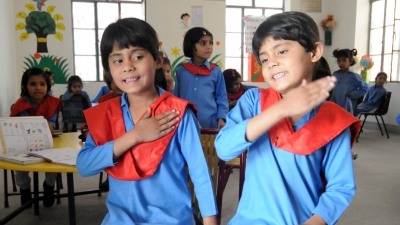GUJRANWALA, Pakistan – Nine-year-old Omair Saleem can’t believe his luck. At his new school, teachers let him play with colorful math puzzles, while older students conduct science experiments in a modern lab or learn intricate computer codes in a room filled with desktop terminals.
Even better, Saleem’s father doesn’t have to pay school fees or purchase his textbooks anymore. That’s because his parents recently pulled him out of private school and enrolled him in a government school.
“My father used to think private school was better,” explains Saleem, shyly plucking at new gray trousers. “But everyone told him this school is very good now, so he shifted my brother and me here.”
It’s a trend that confounds many long-held beliefs about the inferiority of government schools, says Haji Munawar Hussain Javed, principal of the Gujranwala Government Comprehensive School (GCS).
“In the past, parents were eager to avoid government schools. They were considered crowded, dirty, a last option for the poor,” he says. “But the results of students here are much better now, so people are shifting their kids and our attendance is increasing.”
As further proof, Javed leads visitors to a hallway where a brightly painted sign celebrates the names of 53 students who recently passed their Class 10 Secondary School exams with an A+.
Reforms improve access and quality
Javed attributes much of this success to education reforms launched in 2003 by the government of Punjab, which aim to improve access, quality and governance in education for about 12 million children in the country’s largest province.
The World Bank has provided support to the education reform program from its inception, providing financing of close to $800 million over the last 10 years.
Although the region is highly industrialized and agriculturally rich, student enrollment in primary schools here was just 45 percent in 2001-02.
During the last decade, primary enrollment has increased to more than 61 percent, and lagging female student enrollment has improved so that 59 percent of girls now go to school in Punjab.
World Bank funding has also helped provide 34 million free textbooks to more than 11 million students in the 2010-11 academic year, helped hire more than 200,000 new teachers since 2003 and improved school infrastructure by adding toilets, boundary walls, and new classrooms.

